Locust Leafminer
ID
3101-1528 (ENTO-529NP)
Introduction
Locust leafminer, Odontota dorsalis (Thunberg), is a leaf-feeding beetle native to North America (Fig. 1). Black locust (Robinia pseudoacacia) is the preferred host for the larval stage, but adult locust leafminer also feeds on honey locust (Gleditsia triacanthos), apple, oak, birch, beech, elm, cherry, and hawthorn. Locust leafminer is known to feed on soybean leaves as both larvae and adults, but damage to this crop is considered minor. Locust leafminer belongs to the family Chrysomelidae in the order Coleoptera.
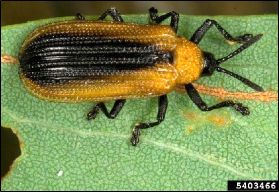
Identification
The adult is a small, flattened, elongated beetle that measures about 5-6 mm (0.2 inch) long (Fig. 1). The head, legs, and antennae are black. The thorax and the outer margins of the wing covers are orange with a prominent black dorsal stripe running down the middle of the back and broadening at the tip of the abdomen. The wing covers are grooved with deep pits. The flat, white, oval eggs are laid on the underside of the leaves in small clusters of 3-5 and covered with excrement. The yellowish larvae have a dark head capsule, a darkened dorsal plate directly behind the head, and dark legs (Fig. 2). The larvae are flattened as well, with small fleshy projections on the lateral sides.
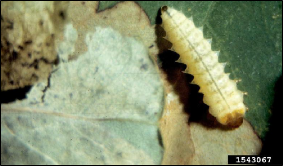
Damage and Life Cycle
There are two generations a year in Virginia. Adults overwinter in bark crevices and leaf litter of black locusts. They become active in late spring about the time black locust leaves start to unfold. Adult locust leafminers initially feed on the lower surface of leaves, skeletonizing and chewing small holes. Females lay eggs on the new leaves. Newly hatched larvae feed gregariously, but eventually they create their own individual blotch mines between the upper and lower surfaces of a leaf (Fig. 3). Larvae pupate inside their mine and emerge as new adults in July.
Heavily infested trees may drop the old, damaged leaves and releaf. If the tree has grown fresh new leaves in July, the first-generation adults will lay eggs on the new foliage and the second-generation larvae will mine those leaves. The second-generation adults will emerge in late summer and seek sites for overwintering. By late August, locust trees may have noticeably ragged, curled, brown or bleached foliage as the damaged leaves dry out in the sun and wind (Fig. 4).
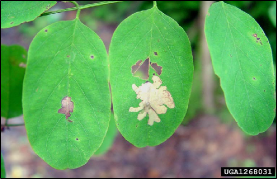
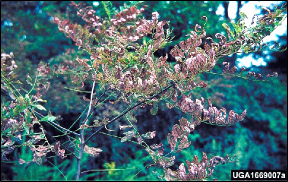
Control
Black locust trees are rarely grown for ornamental or shade tree purposes and they usually have a low economic value. Leaf skeletonizing by adult locust leafminers is usually very minor and does not warrant control measures. Leafmining by larvae is usually only detrimental on trees that are attacked repeatedly. If control is warranted, the best time to treat locust leafminer is in late May or early June, when the adults are active and the mines are less than 6.4 mm (0.25 inch) long. Insecticides with some systemic activity, such as imidacloprid, will give the best control.
Locust leafminers rarely reach economic thresholds on soybeans (Fig. 5). Control is only warranted if defoliation of the vegetative stages reaches 35% or more. Most common soybean insecticides used at a low rate will give good control.
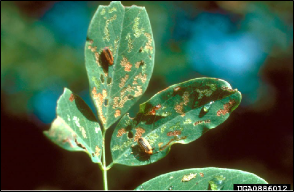
Remarks
Locust leafminer was once considered a sporadic pest that would cause outbreaks only every few years. More recently, outbreaks have occurred year after year in some locations, such as along highways or on the edges of fields. While heavily infested trees may look like they are dying, locust leafminer does not actually cause much tree mortality at these sites and the trees seem to be able to withstand repeated defoliation year after year.
Revised
Theresa A. Dellinger, November 7, 2022.
Virginia Cooperative Extension materials are available for public use, reprint, or citation without further permission, provided the use includes credit to the author and to Virginia Cooperative Extension, Virginia Tech, and Virginia State University.
Virginia Cooperative Extension is a partnership of Virginia Tech, Virginia State University, the U.S. Department of Agriculture (USDA), and local governments, and is an equal opportunity employer. For the full non-discrimination statement, please visit ext.vt.edu/accessibility.
Publication Date
November 22, 2022



